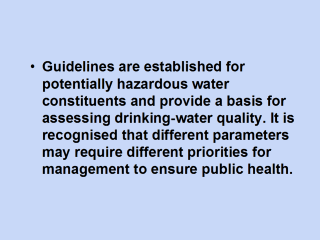 |
Priority
setting should be undertaken on the basis of a systematic assessment. The
fundamental principle is that the assessment should be a collaborative
effort. All relevant agencies should be involved, as much of the necessary
information may be available in existing documentation from various sources,
from previous studies or from a number of agencies. It may require the
formation of a broad based inter-agency committee including authorities such
as health, water resources, water supply, environment, agriculture and
geological/mining to establish a mechanism for sharing information and
reaching consensus on drinking-water quality issues.
Sources of information that should be considered to determine
priorities include catchment type (protected, unprotected), geology,
topography, agricultural land use, industrial activities, and sanitary
surveys, records of previous monitoring, inspections, and local, and
community knowledge. The wider the range of data sources used, the more
useful the results of the process will be. In many situations, authorities
or consumers may have already identified a number of drinking-water quality
problems, particularly where they cause obvious health effects or aesthetic
problems. These existing problems would normally be assigned a high
priority. |
